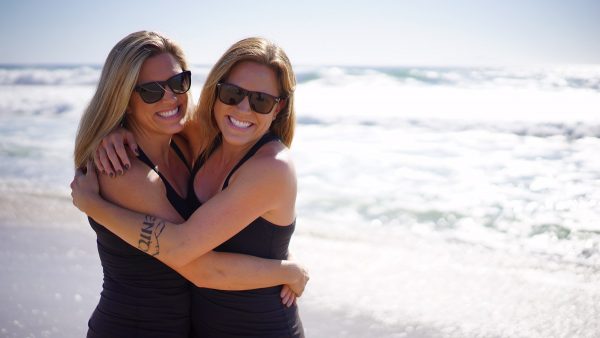The Recovery of Craig K.





Monday morning is a stressful time for many people. Anxiety about work or a depressed mood are not beneficial for anybody but they can be dangerous relapse triggers for people in recovery from addiction.
One way to deal with the Monday blues is to confront it head-on and make a virtue of it. Michael Arnold is the director of alumni and recovery support services at Harmony Foundation. She has found an engaging way to help people in recovery snap out of any dark moods they may be experiencing.
In May, Michael started a podcast called “Monday State of Mind” to give the recovery community a positive start into the workweek. Her sheer boundless enthusiasm alone will cheer up your Monday—or any other day for that matter. “I know the good that happens when I choose to be consciously aware of my state of mind,” explained the woman known as the “Hurricane of Happiness” in episode one. An alumna of Harmony herself, Michael continues to use the tools that were given to her while she was there as a client.
The fuel behind “Monday State of Mind” is her intense desire to “recover out loud” and in the process help others in the same situation. “ At Harmony, I get to help alumni implement the foundation they learned into their daily lives and help show them how to continue to take their power back by creating and living lives that are filled with continuous growth, meaningful connection, service, gratitude, and so much more.”
“Monday State of Mind” means to tackle thought-provoking questions that relate to recovery and how to apply the answers into the daily life of listeners. Michael aims to challenge listeners to ask themselves whether their state of mind is helping them catapult their week forward, or whether it is harming their week.
And when things don’t go your way, you just have to deal with it—appropriately. The week leading up to episode nine reminded Michael to keep it authentic when she realized that her request for listener questions had resulted in zero replies. In typical Michael Arnold fashion, she turned that Monday disappointment around and made it the topic of the episode that followed four episodes about humility after all.
At first, she got anxious and started blaming herself for this “failure.” Destructive, self-defeating thoughts showed up: “Why are you even doing this podcast?” and “No one is listening!” Then her ego chimed in: “Michael, you can’t admit that no one submitted questions. Just make some up!” But she felt fairly uneasy about making things up—she didn’t want to be a fraud. Instead, Michael called a friend who put her straight: “Michael, this is your opportunity to really show what you have been talking about. Your topics are happening to you. You have a great opportunity to be humble to the world and talk about it.”
Michael realized that “in order to change your state of mind you have to make tough decisions to grow. You have to be prepared to be a little uncomfortable.” She understood that she can’t expect listeners to be transparent, truthful, and vulnerable if she is not prepared to be so herself. After all, nobody is perfect and you can’t beat the Monday blues by faking it.
_____________________
Catch the podcast here: https://stage.harmonyfoundationinc.com/monday-state-of-mind/
Michael Arnold is the co-author of Drowning in Addiction: A Personal Guide to Recovery
Subscribe on any of these podcast platforms!
Apple Podcasts
Spotify
Google Podcasts
Stitcher

By Michael Rass
Although e-cigarettes have been around for more than a decade, vaping rates have dramatically increased in recent years, particularly among teens. According to the Child Mind Institute, “e-cigarettes are now the most frequently used tobacco product among adolescents—some 2.1 million middle and high school students were e-cigarette users in 2017—far surpassing traditional combustible cigarettes.”
The Food and Drug Administration announced new steps in September to address the “epidemic of youth e-cigarette use,” issuing “more than 1,300 warning letters and civil money penalty complaints (fines) to retailers who illegally sold JUUL and other e-cigarette products to minors.” The Surgeon General warns that nicotine is harmful to children and young adults. “E-cigarettes typically contain nicotine as well as other chemicals that are known to damage health. For example, users risk exposing their respiratory systems to potentially harmful chemicals in e-cigarettes.”
Vaping products have risen in popularity among teenagers and young adults because they are considered a safer alternative to traditional smoking and provide a clandestine means of using marijuana. In a 2017 state survey, 27 percent of Colorado youths reported using e-cigarette products—the picture is not much different in other states. Vaping is also endemic among young adults in their twenties and thirties.
The popularity of vaping co-evolved with the widespread perception that marijuana use is harmless. In recent months, too many young Americans had to learn the hard way that neither vaping nor cannabis use is without risk, especially when the two are combined.
Colorado is now one of several states investigating severe lung injury associated with vaping. There have been at least nine cases in the Centennial State. Colorado parents Ruby and Tim Johnson told CBS that vaping nearly took their daughter’s life. Piper Johnson was diagnosed with Colorado’s first case of a vaping-related illness. The first-year college student had been vaping for more than two years.
As of October 29, the Centers for Disease Control and Prevention (CDC) reported 1888 vaping-related lung-injury cases in 49 states, the District of Columbia, and one US territory. Thirty-seven deaths have been confirmed in 24 states. Early symptoms of these lung injuries include coughing, shortness of breath, fatigue, chest pains, nausea, vomiting, and diarrhea.
Medically, it’s still unclear exactly what is going on. “Despite the accumulating data on the clinical and imaging features of vaping-associated lung injury, its pathology is poorly understood,” a number of Mayo Clinic specialists wrote in the New England Journal of Medicine in October. They did discover, however, that all of the cases they studied “had a history of vaping, with 71 percent of them having used marijuana or cannabis oils.”
The CDC currently recommends refraining from using e-cigarette, or vaping, products, particularly those containing THC (the psychoactive component of cannabis). Massachusetts Governor Charlie Baker took the drastic step of declaring a public health emergency and banning in-store and online sales of vaping products in the Commonwealth through January 25, 2020. On the same day, California health officials issued an advisory asking residents to immediately refrain from using e-cigarette devices until a statewide investigation into the risks associated with vaping is completed.
The Colorado Department of Public Health and Environment (CDPHE) is investigating all cases reported to them and advises that “the best way to protect yourself against vaping-related illness is to stop vaping.”
“Findings from other states show that most people who got sick used THC-only products or both THC and nicotine products. That is true in Colorado as well, but because the long-term health effects of vaping are unknown and as information on the illness emerges, our best advice is to consider not using vaping products.”
Coloradans who think they may have been sickened by any vaping product should contact their doctor, local public health agency, or poison control at 1-800-222-1222.
Harmony Foundation supports long-term behavioral change. When clients choose our program for recovery from alcohol and drug addiction, they are taught coping skills to help them avoid all addictive substances and embrace a healthy lifestyle. This is why we do not support vaping on campus and provide recovery skills classes that teach healthy choices.
Replacing alcohol or opioid misuse with increased nicotine intake is not a good idea. True recovery goes beyond abstinence from illicit drugs and alcohol. The goal of addiction treatment at Harmony is a comprehensive body-mind-spirit reset. The cessation of substance misuse is only one aspect of that reset.
________
LINKS
CDPHE information on vaping and lung illness https://www.colorado.gov/pacific/cdphe/vaping-lung-illness
Surgeon General’s fact sheet on vaping. https://e-cigarettes.surgeongeneral.gov/

When I stopped drinking in April of 2005, I wondered if I would ever be able to have fun again outside of the bar scene. I feared I would never enjoy a live concert again, one of my greatest joys in life. As a single person, I had no idea how I’d ever go on a date again. “Who goes on a date and doesn’t drink?” For that matter, “Who goes out to eat at a nice restaurant (date or no date) and doesn’t have a glass of wine with their meal!?” (Did I mention the aperitif, the bottle of wine at dinner, and the after-dinner drinks that turned into shots towards the end of the evening?) I’d ruined all prospects of fun in my life! I determined I would always be, from that day forward; bored, boring, and surrounded by other bored and boring people. I was working in a bar. Most of my friends worked in bars and restaurants. Almost all my friends drank alcohol.
In those first few years as a non-drinker, I struggled to find activities that didn’t involve alcohol. However, more often than not, I participated in events that were drenched in alcohol and drug use and risked my new lifestyle and trajectory towards wellness. As a therapist, I would never have advised this to any of my clients. Why hang out in a candy shop if you are trying not to eat any added sugar? It seems the obvious choice would be to find a broccoli shop instead. But, broccoli shop? How bland, how boring, and how nonexistent! We needed a place that still felt like the candy shop without the candy! Still sweet, still vibrant, still FUN! Ok, enough with the metaphors. I wanted a nonalcoholic bar! A place for connection with other people making similar life decisions, a place without the risk but still social. I pondered that idea for a while, and then let it drop. It took several more years until that thought became a reality, in fact, it wasn’t until 2018 that I told this idea to a friend and she encouraged me not to ponder it anymore but to do it. Thank you, Allison! And, Bar Zero started to become a reality.
Once I started sharing this idea, I learned that so many others in recovery were longing for a space like this. I definitely was not the only one, and several people even mentioned calling it “SoBar,” which was our original name! I heard stories of friends in recovery having discussions about building a space just like this, a place for connection and community building for people in recovery. Many had the same questions I did in early recovery with the general theme being, “Will I ever have fun again?”
Just as this concept was forming and becoming something more than a shared idea, the sober curious movement started catching on. What timing! Now it’s not only those of us who consider ourselves “in recovery” looking for safe spaces, it’s also a new group of people looking for fun and for fewer hangovers yet still going out and enjoying a Friday night on the town! And, the press, the bar and restaurant industry and the general public are talking about not drinking! And, about drinking really tasty, alternative nonalcoholic drinks! They’re calling them “mocktails,” “zero-proof beverages,” “spirit-frees.” They’re being sold by Coca-Cola in a new line of nonalcoholic drinks called Bar None https://www.drinkbarnone.com/. They’re being made by distilleries, even! Non-alcoholic distilled beverages are made by Seedlip https://seedlipdrinks.com/us and starting to become more and more popular across the US after originating in the UK. And, the most fun part, local bartenders are starting to get excited and inspired to make high-end and delicious drinks without alcohol in them! Creativity and talent are showcased by the top bartenders in town and they are getting written up by local publications! https://coloradosun.com/2019/08/02/denver-sobriety-movement/
I’ve happily given interviews to the Denver Post (coming soon), Westword (twice!) https://www.westword.com/restaurants/sobar-could-soon-be-denvers-first-restaurant-for-and-by-the-sober-community-11105915 https://www.westword.com/restaurants/sobar-rebrands-as-bar-zero-with-plan-to-launch-catering-company-11408158, and Dining Out (also coming soon!) People are interested and getting involved with this new way of looking at drinking, or rather, not drinking and it is so thrilling to watch and experience!
Whatever they are calling these new drinks and establishments popping up across the country, I’m so excited to be a part of this shift, this movement! Without shame, without stigma, a lot more people are speaking clearly about what makes so much more sense, connection and a “life” without the booze yet still having a social outlet and space that includes delicious food and DRINKS!
Bar Zero is the space we’ve been craving. We are going to make it a reality. We need help doing that. Bar Zero is a 510 (c) 3 nonprofit organization and we have a long way to go before opening a brick and mortar restaurant. We are creating space for connection and community building. AND, also very excitingly, we are offering on the job training for people in early recovery from substance use problems. We know the “sober curious,” the “gray area drinkers,” those of us in recovery, and our communities at large need a place like this. Please help us bring this to Denver!
Our first Fundraiser is planned for September 11th, 2019 at Dazzle Jazz in downtown Denver. In partnership with Friends and Family, a Colorado nonprofit group for people who work in the hospitality industry, we are putting on a Zero-Proof Beverage Mix-Off! See the details on this amazing event on our website https://barzerodenver.org/ on the event page and join us for a unique and fun evening. Denver’s top mixologists will compete for a spot on the Bar Zero beverage menu. A panel of guest celebrity judges will taste and rate original eye-catching, mouthwatering nonalcoholic drink recipes. And you’ll get to be the judge too, by tasting a collection of awesome Zero-Proof Beverages and helping to pick the People’s Choice Award winner, all while enjoying new food menu creations and pairings by Chef Paul Rose.
Bar Zero’s Mission: Connection through food, intentional community, and professional collaboration for a continued life worth living in recovery.

More than two-thirds of drug overdose deaths in the United States in 2017 involved opioids, according to the Centers for Disease Control and Prevention, escalating an epidemic the CDC says “continues to worsen and evolve.” From 2016 to 2017, opioid-related overdose deaths increased 12 percent overall, surging among all age groups 15 and older.
The CDC report’s recommendations for curbing opioid-related overdose deaths include “increasing naloxone availability, expanding access to medication-assisted treatment, enhancing public health and public safety partnerships, and maximizing the ability of health systems to link persons to treatment and harm-reduction services.”
Naloxone is a medication often used by first responders because it can rapidly reverse opioid overdose. It is an opioid antagonist—it binds to opioid receptors and can reverse and block the effects of other opioids. It can quickly restore normal respiration to a person whose breathing has slowed or stopped as a result of overdosing with heroin or prescription opioid pain relievers.
Medication-assisted treatment (MAT) is used to decrease opioid use, opioid-related overdose deaths, criminal activity, and infectious disease transmission. Medications used for the treatment of opioid use disorder are buprenorphine (Suboxone, Subutex), methadone, and extended release naltrexone (Vivitrol). Some of these drugs are controversial in the recovery community because they are themselves opioids.
The National Institute on Drug Abuse, a US government research institute, clarifies that contrary to what some critics say, “methadone and buprenorphine DO NOT substitute one addiction for another. When someone is treated for an opioid addiction, the dosage of medication used does not get them high–it helps reduce opioid cravings and withdrawal. These medications restore balance to the brain circuits affected by addiction, allowing the patient’s brain to heal while working toward recovery.”
The use of these medications should always be combined with behavioral counseling with the ultimate aim of ceasing all substance misuse.
HOPE – Harmony’s Opioid Programming Experience
Harmony has provided all clients with medication-assisted treatment for many years. This combination of education, counseling, and the use of medication in early recovery is part of the Harmony philosophy. HOPE expands MAT to include medications that alter the physical response to opioids, reduce cravings, and give the patient time to heal from the psychological, social, and spiritual wounds of addiction.
“It’s important to remember that MAT is only a small part of the picture,” says Harmony’s medical director Christopher Reveley. “That is why we call it ‘medication-assisted’ treatment, because by itself it is not the treatment. Used alone it has a low probability of being successful.”
At Harmony, HOPE begins with thorough medical and psychological evaluations. Collaboration with the patient, members of the interdisciplinary team and, when appropriate, family and referral sources, determine the most effective treatment plan. All HOPE clients are invited to participate in weekly support groups led by a professional addiction counselor. These groups address the unique challenges of early opioid recovery, including uncomfortable physical and psychological symptoms, cravings, and strategies to avoid relapse. In this setting, clients support each other and are educated about the process of recovery.
Medication-assisted therapy may help stabilize the patient for these challenges in early recovery. “It gives people an opportunity to step out of the chaos of addiction and consider other ways of being,” says Dr. Reveley. “I never felt that buprenorphine was meant as a lifelong or even long-term solution.” Although there may be exceptions. It all depends on the individual needs of the patient. Reveley remembers a patient who had been on methadone for 46 years. “He tried to taper off a dozen times and relapsed to heroin use every single time. His family was initially very opposed to him being on methadone but eventually they told him ‘this is working, your life depends on it.’ So there are people on either end of the bell curve but in most cases buprenorphine is only a small but important part of the solution.”
Buprenorphine can be an important tool, especially in early recovery from opioid use disorder. The medication offers patients the opportunity to start living a “normal” life, far removed from the drug culture lifestyle they may have been immersed in while using heroin and other opioids. People are dying every day from opioid overdoses, especially in the age of the fentanyl scourge. Buprenorphine may provide the buffer that enables them to launch into sustained recovery. It is a buffer that can save people with addiction from a potentially lethal overdose.
Harmony has been treating addiction for 49 years and HOPE is now offered to all Harmony clients with opioid use disorders. The program involves enhanced medical, counseling, and case management services specifically tailored to meet these clients’ unique needs.
The Harmony care team works closely with clients who choose to include buprenorphine in their treatment strategy. This will typically involve full participation in HOPE and a recommendation for participation in Harmony’s Transitional Care Program (TCP), an intensive, 90 day intensive outpatient program coupled with monitored sober living and medication management by Harmony providers. When clinically indicated or to accommodate client preference, Harmony’s case managers may refer clients to other programs with similar services.
If you or someone you know is struggling with opioid use disorder and needs help, call Harmony at 970-432-8075 and one of our admissions specialists can discuss next steps.

Addiction is a family disease. The Recovery Book advises family members of people in recovery that “Everyone in your family, as well as other people in your lives, has been affected by addiction in some way. Now you all need to work on getting your lives back to some kind of normal.”
Michael Arnold is a recovering alcoholic who now works as an alumni relations manager at the Harmony Foundation. In a recent Facebook Live with her twin sister, Michael and Casey talked about the impact Michael’s addiction and recovery had on their relationship. Both siblings demonstrated how important clear and honest communication is for the family dynamic.
Michael talked about the need to share with “brutal honesty what addiction can do to your family.” Casey talked about how hard it was for her to watch Michael decline in active addiction, realizing there was nothing she could do, that Michael had to save herself.
Michael recalls doing things to her family that “just weren’t nice.” Casey remembers all too well. Seven years ago Michael helped to put her twin sister briefly in jail—just to hurt her. Michael was in such a bad place that to hurt her sister made her feel better.
“I never thought I could be close with Michael again, never thought I could trust her again,” Casey said. But change can happen. Recovery can work miracles. “Michael has changed. She is not the person she was seven years ago,” Casey said. “She is not that selfish person that put me in jail. She’s working very hard at it every day.”
For desperate family members the trick is to be patient and supportive. “Don’t hammer people in recovery about all the mistakes they made in active addiction” all the time. “Show your love,” Casey said. “You need to have grace and patience with them. As family members you have to give them space to recover, the harder you are on them the worse it’s going to be.”
Appealing to people in the audience who have family members with addiction, Casey said, “You have to choose either to be there and support them or walk away. You can’t live in the middle and hold their past wrongdoings against them—that doesn’t help them recover. I have nothing but complete love for Michael now and I’m just so proud of her. It’s been a journey for both of us.”
Michael shared her side of that journey. Only “when I went through rehab did I get the tools to tell myself everyday to have that patience, to be so grateful that I’m sober. I have to know that my family will trust me; that they should realize that I’m a changed person but time is not on my side.”
It’s important to remember that recovery is a process. “I thought simply that Casey and I would be okay now that I’m sober. The relationship would be fine but it wasn’t,” Michael remembers. “Casey gave me that space for about a year to recover, but then she said ‘we need to talk about what happened’ so that we can move forward.”
Casey had to tell Michael what she had done to her and “she took it hard. I love you, I forgive you, but you have to earn the trust back.” That shook Michael, “but now our relationship is even stronger because you have to be able to open up about these things or they will simply fester.”
Making amends is an ongoing process for Michael now and Casey knows it. “Michael is ruthless and relentless about her recovery—she has even written a book about it. She is working hard every single day and that is all you can ask.”

You may recall the American Romantic Comedy “Failure to Launch” in 2006 that describes a 30-something man struggling to leave the nest. This concept isn’t foreign when describing young adults’ struggle with achieving the next milestone of independence: moving out of their parents’ house. Dr. Jean Twenge writes extensively on the trends of stagnation and delayed pursuit of independence in both the Millennial and iGen generations. But what can we do to support confidence and the pursuit of autonomy and freedom in our young adults?
An Uphill Battle
For many young adults, American society has given them expectations that they can do anything they want, be anything they want, follow their dreams, and thus, never settle for mediocre in their identity, career, or relationships. For the adult child, this becomes a rude awakening when facing competitive college admissions, fighting for quality jobs, and budgeting to live on their own with the rising cost of living. Dr. Twenge speaks extensively about the ways young adults are set up to fail—highlighting loneliness, a lack of self-esteem, and elevated anxiety and depression as some of the challenges of our 18-35-year-olds.
Recognizing that these challenges may lead to stagnation and loss of confidence, it is important to foster hope for these generations, both in themselves and the communities they cultivate that can help them achieve success. Below are some ideas for young adults to support their transition to independence from their parent’s home:
Parenting Parameters
Fostering hope and confidence is not exclusively the job of professionals. The support of parents can also be crucial to the confidence of a young adult. Here are some ideas for parents to encourage the exit from the nest:
In whatever ways one accesses the confidence to pursue independence, knowing there are loving, caring connections between the person and others is a vital component of their success. There is no rule book for how to move from failure to launch to thriving in freedom. In a generation that feels more lonely and anxious than ever, community connection and meaningful interactions can help. We can support the next generations in their success though encouragement and kindness, and in this effort, we all win.
“Change is hardest at the beginning, messiest in the middle, and best at the end.” ~Robin Sharma
Khara Croswaite Brindle, MA, LPC, ACS, is a Licensed Professional Counselor in the Lowry Neighborhood of Denver, Colorado. She received her Masters Degree in Counseling Psychology from the University of Denver with a focus on community based mental health. Khara has experience working with at-risk youth and families, including collaboration with detention, probation, and the Department of Human Services. Khara enjoys working with young adults experiencing anxiety, depression, trauma, relational conflict, self-esteem challenges, and life transitions.

“I don’t want to be here. I’m not going to say anything. I don’t know. Why should I talk to you?” You may find yourself thinking or saying thoughts like these in response to pressures to engage from a program, family, or friends. Perhaps you aren’t ready to share what’s brought you here, or what the challenges are that you are facing in this moment. Perhaps you feel like your personal freedom has been taken away, your choice to participate of your own free will. Understanding that you may feel angry, resentful, or withdrawn, please consider the following in support of getting the most out of something that is identified as mandatory.
Blocking or Belonging
You may come from a different background or hold different values from those you come into contact with, so what brings people together in this process? Shared experience around homelessness, financial instability, substance abuse, conflict in relationships, or a lack support can help one feel less isolated and alone in their experience. Although each person’s story is their own, the feeling of connection to others and belonging can go a long way in having an experience feel less mandatory and more voluntary. When you observe others engaging in the program or group, you may find yourself asking:
For many involved in Alcoholics Anonymous (AA), they speak of the community as an equally powerful element as the 12 Steps in to their ability to actively participate in their own sobriety. Due to the friendships they make, they feel they have a connection to others in ways that feel encouraging and uplifting in moments of challenge or struggle.
Building Perspective
In addition to identifying a supportive community, how you approach the experience for yourself matters. Do you have realistic expectations of what you can accomplish both short and long term? Can you set yourself up for success in your work with others? When starting this process, it is helpful to understand basic needs as the foundation for progress. Educating yourself on how basic needs such as food, safety, and shelter provide the foundation of stability gives you permission to organize goals for success. Abraham Maslow, who identified this relationship in the Maslow Hierarchy of Needs, emphasizes that only when basic needs are met can one focus on higher work around self-esteem, sobriety, and relationships.
Relational Rapport
When exploring relationships, research tells us that therapeutic rapport accounts for more than any other factor when measuring progress towards goals set in therapy. In other words, the therapeutic relationship, unconditional positive regard, and power of feeling seen, heard, understood, and supported has positive results on goal progression. If your past experience involves trust or mistrust, being aware of how therapy and/or relationships have helped or hindered you in the past can put current resistance and reluctance in perspective. A few questions that you may find helpful at ask at the first meeting with a helping professional include:
All of these questions encourage healthy discussion around the therapeutic process and can provide insight into expectations and measurable goals when engaging a helping professionalin your own growth process.
Mandatory can feel restrictive and stressful when viewed as a loss of control or freedom. What better way to reframe it than to ask yourself, what can make it worthwhile?
“If you change the way you look at things, the things you look at change.” Dr. Wayne Dyer
Khara Croswaite Brindle, MA, LPC, ACS, is a Licensed Professional Counselor in the Lowry Neighborhood of Denver, Colorado. She received her Masters Degree in Counseling Psychology from the University of Denver with a focus on community based mental health. Khara has experience working with at-risk youth and families, including collaboration with detention, probation, and the Department of Human Services. Khara enjoys working with young adults experiencing anxiety, depression, trauma, relational conflict, self-esteem challenges, and life transitions.